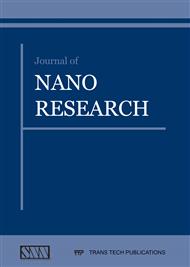[1]
K. -H. Koo, P. Kapur, and K. C. Saraswat, Compact performance models and comparison for Giga scale on-chip global interconnect technologies, IEEE Trans. Electron Dev. 56 (9), p.1787–1798 ( 2009).
DOI: 10.1109/ted.2009.2026196
Google Scholar
[2]
Ashok Srivastava, Yao Xu and Ashwani Sharma, Cabon nano tubes for next-generation interconnects, SPIE, 10. 1117/2. 1201012. 003220 (2010).
Google Scholar
[3]
P. Kapur and K. C. Saraswat, Comparisons between electrical and optical interconnects for on-chip signalling, Proceedings of the IEEE international interconnect technology conference, pp.89-91, (2002).
DOI: 10.1109/iitc.2002.1014897
Google Scholar
[4]
Sudeep Paricha, Nikil Dutt, On-chip communication Architectures-System on-chip interconnect, Morgan Kaufmann , ISBN: 978-0-12-373892-9(2008).
Google Scholar
[5]
Mark S. Lundstrom, Jing Guo, Nanoscale Transistors: Device Physics, l\/lodeling and Simulation, Springer, ISBN 13: 978-0-387-28002-8, (2006).
Google Scholar
[6]
A. Naeemi, Reza Sarvari, and J. D. Meindl, Performance comparison between carbon nanotube and copper interconnects for Giga scale integration (GSI), IEEE Electron Device Lett., vol. 26, no. 2, p.84–86, ( 2005).
DOI: 10.1109/led.2004.841440
Google Scholar
[7]
K. Banerjee and N. Srivastava, Performance analysis of carbon nanotube interconnects for VLSI applications, in Proc. IEEE Int. Conf. Computer Aided Des. San Jose, CA, p.383–390 (2005).
DOI: 10.1109/iccad.2005.1560098
Google Scholar
[8]
Hoyeol cho, kyung-Hoae koo, P. Kanpur and Krishna C. Saraswat, The delay, Energy, and bandwidth comparisons between copper, carbon nanotube, and optical interconnects for local and global application, in proc. IEEE 1-4244-1070-3, (2007).
DOI: 10.1109/iscas.2008.4542034
Google Scholar
[9]
Navin Srivastava And Kaustav Banerjee Performance analysis of carbon nanotube interconnects for vlsi applications, (2005).
Google Scholar
[10]
Fei Yuan, CMOS Current Mode Circuits for Data Communications, Springer, (2007).
Google Scholar
[11]
M. D'Amore, M.S. Sarto, and Tamburrnao, Fast transient analysis of next generation interconnects based on carbon nanotubes, IEEE Transaction on Electromagnetic Compatability., Vol. 52, No. 2, PP. 496-503, (2010).
DOI: 10.1109/temc.2010.2045383
Google Scholar
[12]
Guoqing Chen et all, On-Chip Copper-Based vs. Optical Interconnects: Delay Uncertainty, Latency, Power, and Bandwidth Density Comparative Predictions, 1-4244-0103-8/06 © IEEE (2006).
DOI: 10.1109/iitc.2006.1648640
Google Scholar
[13]
Krishna Saraswat, Hoyeol Cho, Pawan Kapur, and Kyung-Home Koo, Performance Comparison between Copper, Carbon Nanotube, and Optical Interconnects, 978-1-4244-1684-4/08 © IEEE (2008).
DOI: 10.1109/iscas.2008.4542034
Google Scholar
[14]
Kamal H. Baloch, Novik Voskanian, Merijntje Bronsgeest, john comings, Remote Joule heating by carbon nanotube, Nature Nanotube, 8 , (2012).
DOI: 10.1038/nnano.2012.39
Google Scholar


